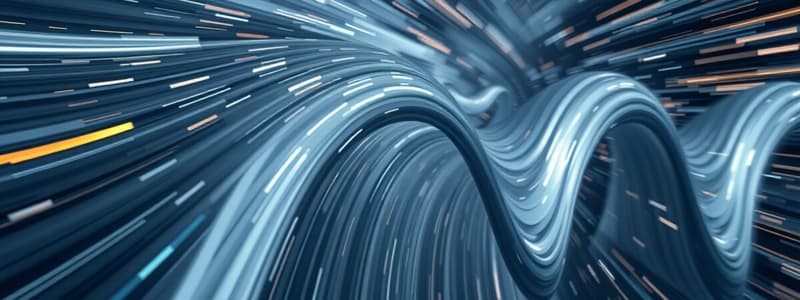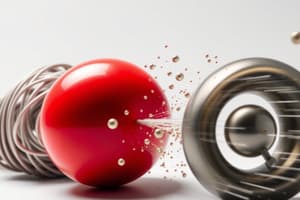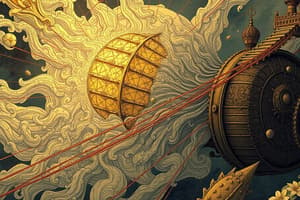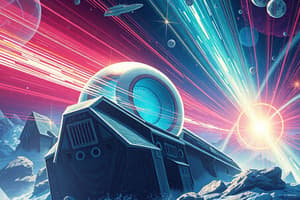Podcast
Questions and Answers
What is mass and how is it measured?
What is mass and how is it measured?
Mass measures the amount of matter in a body and is measured using an electronic balance.
What is the SI unit of mass?
What is the SI unit of mass?
The SI unit of mass is the kilogram (kg).
Define momentum and provide its formula.
Define momentum and provide its formula.
Momentum is the product of mass and velocity, calculated using the formula p = mass × velocity.
Calculate the momentum of a 70 kg skateboarder moving west at 4 m/s.
Calculate the momentum of a 70 kg skateboarder moving west at 4 m/s.
What principle describes the relationship between total momentum before and after an interaction in a closed system?
What principle describes the relationship between total momentum before and after an interaction in a closed system?
Which of Newton's laws explains how a spacecraft accelerates by expelling gas?
Which of Newton's laws explains how a spacecraft accelerates by expelling gas?
What happens during a head-on collision between two identical hockey pucks?
What happens during a head-on collision between two identical hockey pucks?
What does momentum being a vector quantity imply?
What does momentum being a vector quantity imply?
Using conservation of momentum, what is the velocity of the yellow puck after the collision if the blue puck stops?
Using conservation of momentum, what is the velocity of the yellow puck after the collision if the blue puck stops?
After a collision between a 90 kg skier and a 60 kg snowboarder, what is their combined speed if they move together?
After a collision between a 90 kg skier and a 60 kg snowboarder, what is their combined speed if they move together?
What defines a newton, the SI unit of force?
What defines a newton, the SI unit of force?
State Newton's First Law of Motion.
State Newton's First Law of Motion.
What does Newton's Second Law state?
What does Newton's Second Law state?
Define impulse in the context of momentum.
Define impulse in the context of momentum.
If the distance between two masses doubles, how is the gravitational force between them affected?
If the distance between two masses doubles, how is the gravitational force between them affected?
From where does the Sun derive its energy?
From where does the Sun derive its energy?
What is the formula that represents force in Newton's Second Law?
What is the formula that represents force in Newton's Second Law?
What is the change in momentum of a soccer ball when kicked with a force of 8 kN for 0.5 milliseconds?
What is the change in momentum of a soccer ball when kicked with a force of 8 kN for 0.5 milliseconds?
Explain why the acceleration due to gravity varies at different locations on Earth's surface.
Explain why the acceleration due to gravity varies at different locations on Earth's surface.
State Newton’s law of universal gravitation and use it to find the acceleration due to gravity at twice Earth's radius.
State Newton’s law of universal gravitation and use it to find the acceleration due to gravity at twice Earth's radius.
Why does a spacecraft continue traveling to the moon after its engines have been turned off?
Why does a spacecraft continue traveling to the moon after its engines have been turned off?
What is friction and how does it affect the motion of a car on a level road?
What is friction and how does it affect the motion of a car on a level road?
What is a potential reason for a graph of acceleration versus force not passing through the origin, and how can it be adjusted?
What is a potential reason for a graph of acceleration versus force not passing through the origin, and how can it be adjusted?
What is the formula for calculating weight, and how does it differ from mass?
What is the formula for calculating weight, and how does it differ from mass?
Define terminal velocity and explain the forces acting on an object at this speed.
Define terminal velocity and explain the forces acting on an object at this speed.
How does the shape and surface features of the Earth affect the acceleration due to gravity?
How does the shape and surface features of the Earth affect the acceleration due to gravity?
What role does friction play when two surfaces slide over each other?
What role does friction play when two surfaces slide over each other?
What two forces must be analyzed to determine the net force acting on a block being pulled across a surface?
What two forces must be analyzed to determine the net force acting on a block being pulled across a surface?
How can you derive the acceleration due to gravity at Earth's surface using Newton's Law of Gravitation?
How can you derive the acceleration due to gravity at Earth's surface using Newton's Law of Gravitation?
What happens to the weight of an object when it is in free fall in a vacuum?
What happens to the weight of an object when it is in free fall in a vacuum?
What is the significance of calculating the normal reaction force acting on an object on an inclined surface?
What is the significance of calculating the normal reaction force acting on an object on an inclined surface?
How does the frictional force change with the nature of surfaces and the weight of the object?
How does the frictional force change with the nature of surfaces and the weight of the object?
What factors influence how acceleration due to gravity varies across Earth's surface?
What factors influence how acceleration due to gravity varies across Earth's surface?
What is the purpose of adjusting the slope in the experiment involving the trolley?
What is the purpose of adjusting the slope in the experiment involving the trolley?
How can the mass of the system be calculated from the slope in a force vs. acceleration graph?
How can the mass of the system be calculated from the slope in a force vs. acceleration graph?
Explain why mass must be kept constant during the experiment.
Explain why mass must be kept constant during the experiment.
What principle of physics is demonstrated by the experiment with two colliding spheres?
What principle of physics is demonstrated by the experiment with two colliding spheres?
How is the value of acceleration due to gravity calculated from the graph of distance against time squared?
How is the value of acceleration due to gravity calculated from the graph of distance against time squared?
What error-reducing steps can be taken to improve accuracy when measuring free fall?
What error-reducing steps can be taken to improve accuracy when measuring free fall?
In a collision where sphere A comes to rest, how can you calculate the new velocity of sphere B?
In a collision where sphere A comes to rest, how can you calculate the new velocity of sphere B?
What force is required to stop a car of mass 1500 kg traveling at 20 m/s over a distance of 50 m?
What force is required to stop a car of mass 1500 kg traveling at 20 m/s over a distance of 50 m?
What happens to the net force acting on a golfer's trolley if the applied force is less than the force of friction?
What happens to the net force acting on a golfer's trolley if the applied force is less than the force of friction?
How does the direction in which gas is expelled from a spacecraft relate to changing its motion?
How does the direction in which gas is expelled from a spacecraft relate to changing its motion?
Explain how momentum conservation applies during a collision and give an example.
Explain how momentum conservation applies during a collision and give an example.
What are the implications of momentum being a vector quantity in real-world applications?
What are the implications of momentum being a vector quantity in real-world applications?
Describe the relationship between mass and momentum and how it demonstrates inertia.
Describe the relationship between mass and momentum and how it demonstrates inertia.
In what way does the law of conservation of momentum apply to spacecraft acceleration?
In what way does the law of conservation of momentum apply to spacecraft acceleration?
How does controlling the mass of an object impact its momentum in collisions?
How does controlling the mass of an object impact its momentum in collisions?
What is the effect of velocity direction on the momentum calculation during collisions?
What is the effect of velocity direction on the momentum calculation during collisions?
Explain how the total momentum before a collision compares to the total momentum after a collision.
Explain how the total momentum before a collision compares to the total momentum after a collision.
How do Newton's laws of motion apply to the behavior of objects in a frictionless environment?
How do Newton's laws of motion apply to the behavior of objects in a frictionless environment?
What is the relationship between force, mass, and acceleration according to Newton’s second law?
What is the relationship between force, mass, and acceleration according to Newton’s second law?
Describe the implications of impulse in momentum change during a collision.
Describe the implications of impulse in momentum change during a collision.
Flashcards are hidden until you start studying
Study Notes
Mass and Momentum
- Mass quantifies the amount of matter in an object and its resistance to acceleration (inertia).
- Scalar quantity, with SI unit being kilogram (kg).
- Electronic balance is used to measure mass.
- Momentum (p) is defined as the product of mass and velocity: ( p = \text{mass} \times \text{velocity} ).
- Momentum is a vector quantity, SI unit is kg·m/s, and the symbol p indicates its direction as well.
Calculating Momentum
- Example: Momentum of a 70 kg skateboarder moving west at 4 m/s:
- ( p = 70 , \text{kg} \times 4 , \text{m/s} = 280 , \text{kg·m/s} ) west.
- In a closed system, momentum is conserved:
- Total momentum before = Total momentum after.
- Application example: Spacecraft accelerates by expelling gas, demonstrating conservation of momentum.
Collisions
- Two identical hockey pucks collide; blue puck (5 m/s) stops and yellow puck (initially -2 m/s) after collision moves at 3 m/s to the right.
- A 90 kg skier (10 m/s) collides with a 60 kg snowboarder (5 m/s) and moves together at 4 m/s post-collision after applying conservation of momentum.
Force
- Force is a vector quantity representing an influence that causes acceleration, measured in newtons (N).
- One newton accelerates a 1 kg mass by 1 m/s².
- Newton's laws of motion describe the behavior of forces and motion.
Newton's Laws
- First Law: Objects remain at rest or continue moving at a constant velocity unless acted upon by an external force.
- Second Law: The rate of change of momentum is proportional to applied force and occurs in the force's direction. ( F = ma ).
- Third Law: For every action, there is an equal and opposite reaction, acting on different bodies.
Impulse and Gravitational Force
- Impulse (I) is the change in momentum, measured in newton-seconds (Ns).
- Gravitational force acts between masses, defined by Newton’s law of universal gravitation.
- Gravitational force decreases by a factor of 4 if the distance between two masses doubles.
Acceleration Due to Gravity
- Acceleration due to gravity (g) on Earth is approximately 9.8 m/s².
- This acceleration is consistent regardless of mass but varies slightly across the Earth's surface due to its shape and features.
Friction
- Friction opposes motion, acting when two surfaces slide across each other.
- Its strength depends on the nature of surfaces and the object's weight.
- Friction is essential for controlled movement, allowing objects to start and stop effectively.
Terminal Velocity
- A skydiver reaches terminal velocity when the downward force (weight) balances the upward force (air resistance).
- At this point, acceleration ceases, and the participant falls at a constant speed.
Experimental Designs and Calculations
- Experiments validate conservation of momentum by measuring velocities before and after collisions.
- Newton’s law of gravitation can be demonstrated by calculating gravitational force on Earth based on mass and distance.
- Force, mass, and acceleration are interrelated; changes in one will affect the others as per Newton’s second law.
Practical Applications
- Skillful measurements and setups in experiments increase accuracy, such as using smooth spheres to reduce air resistance during free fall tests.
- Maintaining constant mass during experiments helps isolate the variable of force or acceleration for clearer results.
Problem-Solving Techniques
- Utilize established formulas for momentum, force, and gravitational calculations.
- Ensure units are correctly converted for consistency in calculations for accurate results.
Forces on a Skydiver
- A skydiver falling at constant velocity experiences two key forces: gravitational force (weight) acting downward and air resistance (drag) acting upward.
- At constant velocity, the gravitational force is equal to air resistance, resulting in a net force of zero.
Newton's Law of Universal Gravitation
- States that every point mass attracts every other point mass with a force that is directly proportional to the product of their masses and inversely proportional to the square of the distance between their centers.
- Formula: ( F = G \frac{m_1 m_2}{r^2} )
- At a height equal to twice the Earth's radius (i.e., ( 3R )), the acceleration due to gravity can be calculated as ( g' = \frac{g}{9} ), where ( g ) at Earth's surface is ( 9.81 m/s^2 ).
Spacecraft Journey to the Moon
- A spacecraft continues its journey to the moon without engine power due to inertia, the property of an object to remain in uniform motion unless acted upon by an external force.
- In space, there is virtually no friction to slow down the spacecraft, so it can travel over vast distances with minimal propulsion.
Absence of Atmosphere on the Moon
- The moon's low gravitational force is insufficient to retain a substantial atmosphere, allowing gases to escape into space.
- Lack of significant geological activity also contributes to the absence of an atmosphere.
Forces Acting on a Decelerating Book
- The forces acting on a book moving to the right include:
- Gravitational force acting downward
- Normal force acting upward
- Frictional force acting to the left, opposing motion
Friction
- Friction is the resistance force that occurs when two surfaces interact, preventing or slowing down relative motion.
- Types of friction include static (prevents motion) and kinetic (opposes moving objects).
Car Acceleration and Forces
- The net force acting on the car can be calculated using ( F = ma ).
- Car mass = 750 kg, acceleration = 1.2 m/s² implies net force = ( 750 kg \times 1.2 m/s² = 900 N ).
- Engine force = 2000 N, so frictional force = ( 2000 N - 900 N = 1100 N ).
- To calculate the distance traveled before coming to rest after engine off, use ( d = \frac{v^2}{2a} ) with initial speed and frictional deceleration.
Measuring Acceleration Experiment
- Steps involve setting up apparatus, measuring force applied, and timing the movement of the body.
- Graph plotting force against acceleration shows linear relationship indicating Newton's second law.
- To find mass from the graph, use slope interpretation, where slope = ( \frac{F}{a} ).
Conservation of Momentum Experiment
- Set up includes bodies A and B, with A in motion and B at rest, resulting in post-collision movement with shared velocity.
- Aim is to confirm principle of conservation of momentum before and after collision, with momentum calculated by ( p = mv ).
- Energy loss during collisions typically transforms into thermal energy or sound energy.
Acceleration Due to Gravity Experiment
- Measure time ( t ) for an object to fall a distance ( s ) using precise timing tools (e.g., stopwatch).
- Plotting ( s ) against ( t^2 ) yields a straight line allowing determination of gravity from the graph.
- A small, dense ball reduces air resistance, ensuring accurate drop characteristics in experiments.
Mass and Momentum
- Mass quantifies the amount of matter in an object and its resistance to acceleration (inertia).
- Scalar quantity, with SI unit being kilogram (kg).
- Electronic balance is used to measure mass.
- Momentum (p) is defined as the product of mass and velocity: ( p = \text{mass} \times \text{velocity} ).
- Momentum is a vector quantity, SI unit is kg·m/s, and the symbol p indicates its direction as well.
Calculating Momentum
- Example: Momentum of a 70 kg skateboarder moving west at 4 m/s:
- ( p = 70 , \text{kg} \times 4 , \text{m/s} = 280 , \text{kg·m/s} ) west.
- In a closed system, momentum is conserved:
- Total momentum before = Total momentum after.
- Application example: Spacecraft accelerates by expelling gas, demonstrating conservation of momentum.
Collisions
- Two identical hockey pucks collide; blue puck (5 m/s) stops and yellow puck (initially -2 m/s) after collision moves at 3 m/s to the right.
- A 90 kg skier (10 m/s) collides with a 60 kg snowboarder (5 m/s) and moves together at 4 m/s post-collision after applying conservation of momentum.
Force
- Force is a vector quantity representing an influence that causes acceleration, measured in newtons (N).
- One newton accelerates a 1 kg mass by 1 m/s².
- Newton's laws of motion describe the behavior of forces and motion.
Newton's Laws
- First Law: Objects remain at rest or continue moving at a constant velocity unless acted upon by an external force.
- Second Law: The rate of change of momentum is proportional to applied force and occurs in the force's direction. ( F = ma ).
- Third Law: For every action, there is an equal and opposite reaction, acting on different bodies.
Impulse and Gravitational Force
- Impulse (I) is the change in momentum, measured in newton-seconds (Ns).
- Gravitational force acts between masses, defined by Newton’s law of universal gravitation.
- Gravitational force decreases by a factor of 4 if the distance between two masses doubles.
Acceleration Due to Gravity
- Acceleration due to gravity (g) on Earth is approximately 9.8 m/s².
- This acceleration is consistent regardless of mass but varies slightly across the Earth's surface due to its shape and features.
Friction
- Friction opposes motion, acting when two surfaces slide across each other.
- Its strength depends on the nature of surfaces and the object's weight.
- Friction is essential for controlled movement, allowing objects to start and stop effectively.
Terminal Velocity
- A skydiver reaches terminal velocity when the downward force (weight) balances the upward force (air resistance).
- At this point, acceleration ceases, and the participant falls at a constant speed.
Experimental Designs and Calculations
- Experiments validate conservation of momentum by measuring velocities before and after collisions.
- Newton’s law of gravitation can be demonstrated by calculating gravitational force on Earth based on mass and distance.
- Force, mass, and acceleration are interrelated; changes in one will affect the others as per Newton’s second law.
Practical Applications
- Skillful measurements and setups in experiments increase accuracy, such as using smooth spheres to reduce air resistance during free fall tests.
- Maintaining constant mass during experiments helps isolate the variable of force or acceleration for clearer results.
Problem-Solving Techniques
- Utilize established formulas for momentum, force, and gravitational calculations.
- Ensure units are correctly converted for consistency in calculations for accurate results.
Forces on a Skydiver
- A skydiver falling at constant velocity experiences two key forces: gravitational force (weight) acting downward and air resistance (drag) acting upward.
- At constant velocity, the gravitational force is equal to air resistance, resulting in a net force of zero.
Newton's Law of Universal Gravitation
- States that every point mass attracts every other point mass with a force that is directly proportional to the product of their masses and inversely proportional to the square of the distance between their centers.
- Formula: ( F = G \frac{m_1 m_2}{r^2} )
- At a height equal to twice the Earth's radius (i.e., ( 3R )), the acceleration due to gravity can be calculated as ( g' = \frac{g}{9} ), where ( g ) at Earth's surface is ( 9.81 m/s^2 ).
Spacecraft Journey to the Moon
- A spacecraft continues its journey to the moon without engine power due to inertia, the property of an object to remain in uniform motion unless acted upon by an external force.
- In space, there is virtually no friction to slow down the spacecraft, so it can travel over vast distances with minimal propulsion.
Absence of Atmosphere on the Moon
- The moon's low gravitational force is insufficient to retain a substantial atmosphere, allowing gases to escape into space.
- Lack of significant geological activity also contributes to the absence of an atmosphere.
Forces Acting on a Decelerating Book
- The forces acting on a book moving to the right include:
- Gravitational force acting downward
- Normal force acting upward
- Frictional force acting to the left, opposing motion
Friction
- Friction is the resistance force that occurs when two surfaces interact, preventing or slowing down relative motion.
- Types of friction include static (prevents motion) and kinetic (opposes moving objects).
Car Acceleration and Forces
- The net force acting on the car can be calculated using ( F = ma ).
- Car mass = 750 kg, acceleration = 1.2 m/s² implies net force = ( 750 kg \times 1.2 m/s² = 900 N ).
- Engine force = 2000 N, so frictional force = ( 2000 N - 900 N = 1100 N ).
- To calculate the distance traveled before coming to rest after engine off, use ( d = \frac{v^2}{2a} ) with initial speed and frictional deceleration.
Measuring Acceleration Experiment
- Steps involve setting up apparatus, measuring force applied, and timing the movement of the body.
- Graph plotting force against acceleration shows linear relationship indicating Newton's second law.
- To find mass from the graph, use slope interpretation, where slope = ( \frac{F}{a} ).
Conservation of Momentum Experiment
- Set up includes bodies A and B, with A in motion and B at rest, resulting in post-collision movement with shared velocity.
- Aim is to confirm principle of conservation of momentum before and after collision, with momentum calculated by ( p = mv ).
- Energy loss during collisions typically transforms into thermal energy or sound energy.
Acceleration Due to Gravity Experiment
- Measure time ( t ) for an object to fall a distance ( s ) using precise timing tools (e.g., stopwatch).
- Plotting ( s ) against ( t^2 ) yields a straight line allowing determination of gravity from the graph.
- A small, dense ball reduces air resistance, ensuring accurate drop characteristics in experiments.
Studying That Suits You
Use AI to generate personalized quizzes and flashcards to suit your learning preferences.




